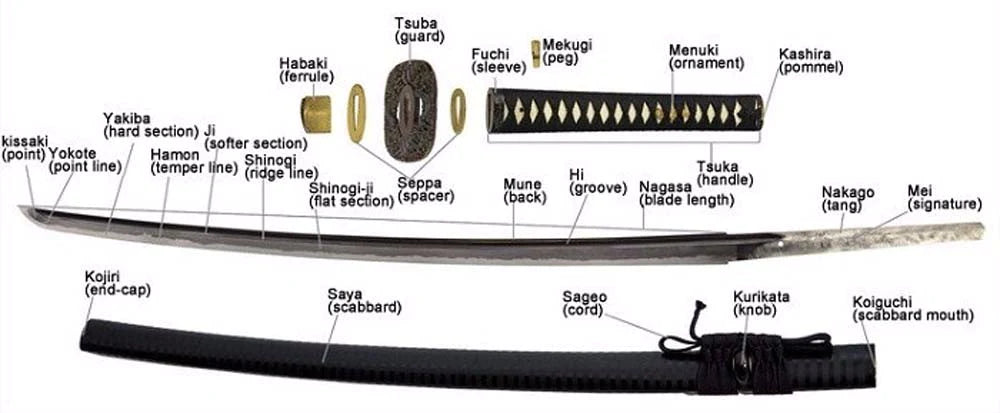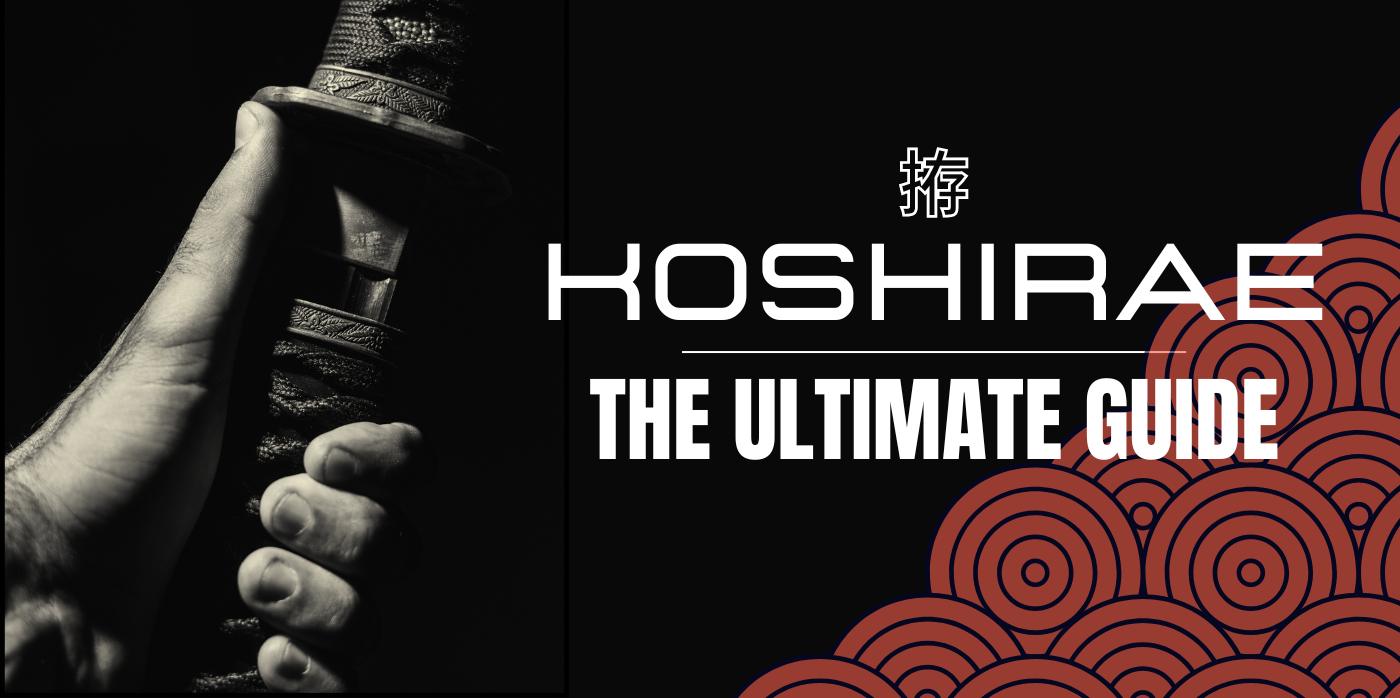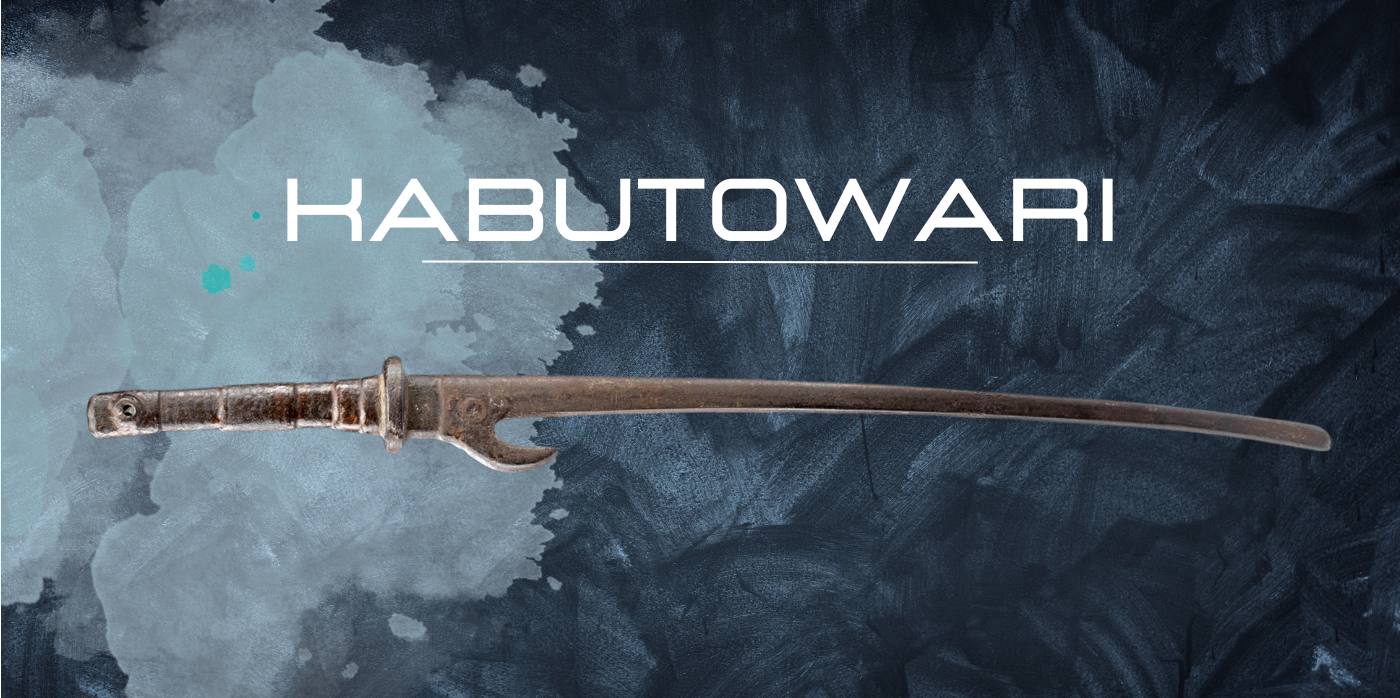What is the Koshirae
Koshirae (拵え) is a Japanese term that refers to the complete mounting of traditional Japanese swords, such as the katana, wakizashi, and tanto. It encompasses all the external components that encase the blade, serving both functional and aesthetic purposes. The elements of koshirae include the tsuka (handle), saya (scabbard), tsuba (guard), and various other decorative and protective fittings like the fuchi (collar of the handle), kashira (pommel), menuki (ornamental under-handle fittings), and habaki (blade collar). Each part is carefully crafted, often with significant artistic value, reflecting the skill of the artisan and the cultural and historical significance of the sword itself.
The koshirae is more than just a sword's housing; it's a work of art that reflects the samurai's status, personality, and aesthetic preferences. The design and decoration of the koshirae can include intricate patterns, symbols, and materials that add layers of meaning and value to the sword.
In contrast to the Koshirae katana, an unadorned katana with no guard is called an Aikuchi, the best-known being the shirasaya, a minimalist katana with a wooden scabbard and no guard.
Understanding Koshirae Components
Each element of koshirae contributes to the sword's balance, usability, and beauty. The scabbard (saya), the hilt (tsuka), the guard (tsuba), and various decorative fittings (fuchi, kashira, menuki) come together to create a harmonious piece that is both a weapon and a work of art. Collectors and enthusiasts of traditional Japanese weapons often seek out specific koshirae for their historical and artistic value.

Here's a list of the main components that make up a traditional koshirae:
- Saya: The scabbard or sheath made of wood, designed to protect the blade. It is often lacquered and can be highly decorative.
- Tsuka: The handle or grip of the sword, usually made of wood and covered in rayskin (samegawa) then wrapped with silk, cotton, or leather cord (ito) to provide a secure grip.
- Tsuba: The guard at the end of the grip that protects the hand. Tsuba can be made of various metals and are often elaborately decorated with themes from nature, history, or mythology.
- Fuchi: The collar or sleeve that sits at the base of the tsuka, next to the tsuba, helping to secure the tsuka's wrapping (ito).
- Kashira: The pommel or cap at the end of the tsuka, which often matches the fuchi in design and material, serving both decorative and functional purposes.
- Menuki: Decorative ornaments placed under the tsuka's wrapping, usually positioned where the fingers grip the handle. These are often designed as animals, gods, or other symbols and can have personal or spiritual significance.
- Habaki: A metal collar that fits between the blade and the tsuba, helping to secure the blade within the saya and preventing it from rattling.
- Seppa: Washers that sit on either side of the tsuba, ensuring a tight fit between the tsuba and the habaki.
- Koiguchi: The mouth of the saya, or the opening where the blade enters the scabbard. It's reinforced to prevent damage and ensure a snug fit.
- Kurikata: A knob or fixture on the side of the saya, through which the sageo (cord) is passed for carrying or tying the sword to the wearer's belt (obi).
- Sageo: The cord that ties the saya to the obi (belt), allowing the sword to be worn. It can be made of silk, cotton, or leather.
- Shitodome: Metal fittings that are inserted into the holes of the kurikata to beautify the sageo's exit points from the saya.
These components can vary in materials, design, and complexity depending on the sword's period, the status of the person who wore it, and the specific traditions of different swordsmiths and artisans.
What are the different types of koshirae
There are several types of koshirae, reflecting the diverse roles, styles, and historical periods of Japanese swords, such as wakizashi koshirae or tachi koshirae. Among these, the buke-zukuri is common for katanas:
Buke-zukuri
The Buke Zukiri is a style of mounting for katanas, characterized by its functional simplicity and understated elegance. Aimed at samurai, it emphasizes practicality and efficiency, while incorporating elements of style and artistry that reflect the wearer's status and the cultural significance of the sword itself.
- Saya (Scabbard): Crafted from lacquered magnolia wood, sometimes adorned with ray skin (same) and often embellished with decorative metal fittings (kodogu). It might also feature a metal end cap (kojiri) for added durability and flair.
-
Tsuka (Handle): Generally wrapped in ray or, more rarely, shark skin, providing a unique texture. It's then encased in a colorful braid (tsuka-ito), usually made of silk ribbons or leather strips. Hidden beneath the wrapping, you'll find ornamental and functional metal fittings (menuki) that add to the aesthetic while ensuring a firm grip.
-
Fuchi: A finely crafted metal ring at the base of the handle. - Kashira: The pommel at the end of the handle, securing the ito's final knot.
- Tsuba (Guard): Not just a protective element, but a piece of art. It features a central hole for the blade and often two more for accessories (Kozuka hitsu ana and Kogai hitsu ana), allowing for the inclusion of a kogatana (a versatile knife) and a kogai (a tool that doubles as a hairpin). To collectors, the tsuba is often seen as the centerpiece of the koshirae, with numerous schools dedicated to its craftsmanship.
- Habaki: A metal collar placed around the blade to ensure a snug fit within the saya.
- Seppa: Two metal washers flanking the tsuba, providing separation from the habaki and tsuka.
- Mekugi: A bamboo pin that securely fastens the sword's tang inside the handle.
- Sageo: A braided cord attached to the saya via a ring or knob (kurigata), used to secure the sword within the wearer's belt (obi).
- Accessories: The kogatana, kogai, and sometimes waribashi (chopsticks) are optional but notable additions, sliding into the tsuba's slots or attached to the saya. When the kogai, kozuka (handle for the kogatana), and menuki are matching, the set is known as mitokoromono, indicative of high-ranking samurai.

Jindachi-zukuri
This style is traditionally used for mounting the tachi, a sword that predates the katana and is distinguished by its characteristic features:
- A larger pommel known as kabuto-gane ("helmet-shaped").
- Occasionally, a metallic menuki that attaches with screws and bolts, providing a unique aesthetic and functional element.
- Instead of a single kurikata, two suspension rings (ashi) are attached to the saya. These rings, through which the sageo (cord) is threaded, facilitate the sword being worn slung from the belt with the blade facing down, as opposed to the katana, which is worn with the blade facing up, slid into the obi (belt).
- The saya of a jindachi-zukuri may include additional reinforcements: a ring of reinforcement (shibabiki), a reinforced tip (kojiri), and metal edge protectors (semegane), enhancing its durability and aesthetic.
Handachi-zukuri
The handachi-zukuri represents a hybrid between the buke-zukuri and jindachi-zukuri styles, embodying characteristics of both:
- It is designed to be worn in a manner similar to the katana but incorporates features of the tachi, such as suspension rings (ashi) and sometimes a larger pommel (kabuto-gane), blending the practical aspects of buke-zukuri with the ceremonial elegance of jindachi-zukuri.
- The handachi-zukuri can be seen as a transitional style, reflecting a period when the samurai class was adapting to changes in warfare and personal armament. It offers a balance between the practicality needed for battle and the ceremonial significance that swords held within samurai culture.
Each of these koshirae types has distinct characteristics that reflect not only the functional and aesthetic considerations of their time but also the evolving nature of Japanese swordsmanship and the samurai way of life. Whether for combat, ceremonial use, or display, the koshirae is a critical component of the Japanese sword, embodying the culture, art, and history of Japan.
How much does a Koshirae cost
The cost of a koshirae can vary widely based on several factors, including the age, historical significance, craftsmanship, materials used, and the specific elements included in the set. Here's a general breakdown to give you an idea:
- Modern Reproductions: For those interested in martial arts or modern sword collections, new koshirae made by contemporary craftsmen can range from a few hundred dollars to several thousand dollars. Basic, functional sets for iaido or kenjutsu practice might start around $200 to $500, while more elaborate, custom-designed pieces can easily exceed $1,000 or $2,000.
- Antique Koshirae: The price for authentic, antique koshirae can be significantly higher, often starting in the thousands of dollars and going up to tens of thousands or more, depending on their historical value, condition, and provenance. Pieces associated with famous samurai, renowned craftsmen, or from particularly notable periods in Japanese history command the highest prices.
- Components and Materials: The cost is also affected by the materials used (such as rare metals, precious stones, or high-quality lacquer) and the complexity of the craftsmanship. For example, a simple wooden shirasaya meant for storing a blade could be relatively inexpensive, while a fully ornamented tachi koshirae with gold inlays and silk wrappings could be exceedingly costly.
- Restoration and Preservation: For antique pieces, the cost of restoration can add to the overall price. Professional restoration of a damaged or worn koshirae to its former glory requires skilled artisans, and their expertise is not cheap.
- Market Demand and Rarity: Like any collectible, the price of koshirae is subject to market demand and the rarity of the piece. Unique, one-of-a-kind, or historically significant pieces can fetch premium prices at auction.




